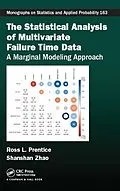The Statistical Analysis of Multivariate Failure Time Data: A Marginal Modeling Approach provides an innovative look at methods for the analysis of correlated failure times. The focus is on the use of marginal single and marginal double failure hazard rate estimators for the extraction of regression information. For example, in a context of randomized trial or cohort studies, the results go beyond that obtained by analyzing each failure time outcome in a univariate fashion. The book is addressed to researchers, practitioners, and graduate students, and can be used as a reference or as a graduate course text.
Much of the literature on the analysis of censored correlated failure time data uses frailty or copula models to allow for residual dependencies among failure times, given covariates. In contrast, this book provides a detailed account of recently developed methods for the simultaneous estimation of marginal single and dual outcome hazard rate regression parameters, with emphasis on multiplicative (Cox) models. Illustrations are provided of the utility of these methods using Women's Health Initiative randomized controlled trial data of menopausal hormones and of a low-fat dietary pattern intervention. As byproducts, these methods provide flexible semiparametric estimators of pairwise bivariate survivor functions at specified covariate histories, as well as semiparametric estimators of cross ratio and concordance functions given covariates. The presentation also describes how these innovative methods may extend to handle issues of dependent censorship, missing and mismeasured covariates, and joint modeling of failure times and covariates, setting the stage for additional theoretical and applied developments. This book extends and continues the style of the classic Statistical Analysis of Failure Time Data by Kalbfleisch and Prentice.
Ross L. Prentice is Professor of Biostatistics at the Fred Hutchinson Cancer Research Center and University of Washington in Seattle, Washington. He is the recipient of COPSS Presidents and Fisher awards, the AACR Epidemiology/Prevention and Team Science awards, and is a member of the National Academy of Medicine.
Shanshan Zhao is a Principal Investigator at the National Institute of Environmental Health Sciences in Research Triangle Park, North Carolina.
Autorentext
Ross L. Prentice is Professor of Biostatistics at the Fred Hutchinson Cancer Research Center and University of Washington in Seattle, Washington. He is the recipient of COPSS Presidents and Fisher awards, the AACR Epidemiology/Prevention and Team Science awards, and is a member of the National Academy of Medicine.
Shanshan Zhao is a Principal Investigator at the National Institute of Environmental Health Sciences in Research Triangle Park, North Carolina.
Inhalt
1. Introduction and Characterization of Multivariate Failure Time Distributions
Failure Time Data and Distributions
Bivariate Failure Time Data and Distributions
Bivariate Failure Time Regression Modeling
Higher Dimensional Failure Time Data and Distributions
Multivariate Response Data: Modeling and Analysis
Recurrent Event Characterization and Modeling
Some Application Settings
Aplastic anemia clinical trial
Australian twin data
Women's Health Initiative hormone therapy trials
Bladder tumor recurrence data
Women's Health Initiative dietary modification trial
2. Univariate Failure Time Data Analysis Methods
Overview
Nonparametric Survivor Function Estimation
Hazard Ratio Regression Estimation Using the Cox Model
Cox Model Properties and Generalizations
Censored Data Rank Tests
Cohort Sampling and Dependent Censoring
Aplastic Anemia Clinical Trial Application
WHI Postmenopausal Hormone Therapy Application
Asymptotic Distribution Theory
Additional Univariate Failure Time Models and Methods
Cox-Logistic Model for Failure Time Data
3. Nonparametric Estimation of the Bivariate Survivor Function
Introduction
Plug-In Nonparametric Estimators of F
The Volterra estimator
The Dabrowska and Prentice-Cai estimators
Simulation evaluation
Asymptotic distributional results
Maximum Likelihood and Estimating Equation Approaches
Nonparametric Assessment of Dependency
Cross ratio and concordance function estimators
Australian twin study illustration
Simulation evaluation
Additional Estimators and Estimation Perspectives
Additional bivariate survivor function estimators
Estimation perspectives
4. Regression Analysis of Bivariate Failure Time Data
Introduction
Independent Censoring and Likelihood-Based Inference
Copula Models and Estimation Methods
Formulation
Likelihood-based estimation
Unbiased estimating equations
Frailty Models and Estimation Methods
Australian Twin Study Illustration
Hazard Rate Regression
Semiparametric regression model possibilities
Cox models for marginal single and dual outcome hazard rates
Dependency measures given covariates
Asymptotic distribution theory
Simulation evaluation of marginal hazard rate estimators
Composite Outcomes in a Low-Fat Diet Trial
Counting Process Intensity Modeling
Marginal Hazard Rate Regression in Context
Likelihood maximization and empirical plug-in estimators
Independent censoring and death outcomes
Marginal hazard rates for competing risk data
Summary
5. Trivariate Failure Time Data Modeling and Analysis
Introduction
Trivariate Survivor Function Estimation
Dabrowska-type Estimator Development
Volterra Estimator
Trivariate Dependency Assessment
Simulation Evaluation and Comparison
Trivariate Regression Analysis via Copulas
Marginal Hazard Rate Regression
Simulation Evaluation of Hazard Ratio Estimators
Hormone Therapy and Disease Occurrence
6. Higher Dimensional Failure Time Data Modeling and Estimation
Introduction
M-dimensional Survivor Function Estimation
Dabrowska-type estimator development
Volterra nonparametric survivor function estimator
Multivariate dependency assessment
Single Failure Hazard Rate Regression
Regression on Marginal Hazard Rates and Dependencies
Likelihood specification
Estimation using copula models
Marginal Single and Double Failure Hazard Rate Modeling
Counting Process Intensity Modeling and Estimation
Women's Health Initiative Hormone Therapy Illustration
More on Estimating Equations and Likelihood
7. Recurrent Event Data Analysis Methods
Introduction
Intensity Process Modeling on a Single Failure Time Axis
Counting process intensity modeling and estimation
Bladder tumor recurrence illustration
Intensity modeling with multiple failure types
Marginal Failure Rate Estimation with Recurrent Events
Single and Double Failure Rate Models for Recurrent Events
WHI Dietary Modification Trial Illustration
Absolute Failure Rates and Mean Models for Recurrent Events
Intensity Versus Marginal Hazard Rate Modeling
8. Additional Important Multivariate Failure Time Topics
Introduction
Dependent Censorship, Confounding and Mediation
Dependent censorship
Confounding control and mediatio…
